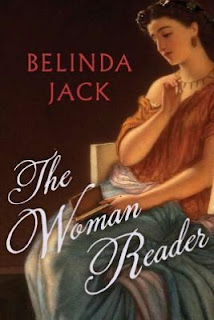 She applied the “Page 99 Test” to her new book, The Woman Reader, and reported the following:
She applied the “Page 99 Test” to her new book, The Woman Reader, and reported the following:You’re not quite a third of the way through my history of women’s reading – The Woman Reader – when you get to page ninety-nine; you have reached the Middle Ages. But you will have read about the earliest literate women who were scribes in the late fourth millennium B.C., in southern Mesopotamia, now southern Iraq. You’ll also have read stories about Sappho, and a number of women in Ancient Rome who were famous for their wide reading. While some men praised their intellectual achievements, others derided them. Juvenal, first to second centuries A.D., wrote, ‘I loathe the woman… who quotes lines I’ve never heard.’ Half way to page ninety-nine you’ll have read a discussion of second century romances and the degree to which they seem to have been written mostly for women. Are these the first works of chick lit.? The so-called Dark Ages were a time of innovation and an increasing number of women writers emerged, sometimes writing adaptations of works by men. Hrotsvit (c. 935- after 973) was a monastic Christian poet who lived and worked in Gandersheim (now Lower Saxony). She entered a Benedictine abbey early on in life and while there re-wrote the plays of Terence to make them more acceptable reading for the sisters. These were mildly feminist works which encouraged the nuns to be active as well as passive in their faiths. Other fascinating women readers emerge in the centuries up to the twelfth, when a first ‘renaissance’ took place and reading and writing flourished. There were notable Muslim women scholars at this point. Page 99 is in some ways the beginning of the story of the ‘modern’ woman reader. It tells of Christine de Pizan who read widely and then took to authorship. She was appalled by the misogynism of the day and wrote:Learn more about The Woman Reader at the Yale University Press website.An extraordinary thought became planted in my mind which made me wonder why on earth it was that so many men… have said and continue to say and write such awful damming things about women and their ways. I was at a loss how to explain it. It is not just a handful of writers that do this… . It is all manner of philosophers, poets and orators too numerous to mention, who all seem to speak with one voice and are unanimous in their view that female nature is wholly given up to vice.Christine de Pizan believed that women had a natural capacity for reading and study, and innate political skills. She saw no reason why they shouldn’t receive the same education as men and participate in public life. So, page 99 is typical in the sense that it tells the story of one feisty woman reader and there are myriad examples in my book. But the variety of interesting women increases dramatically as the centuries pass. I particularly enjoyed writing about the eighteenth century. It’s when women fans started to write to the well-known writers of the day – who often published in instalments – begging them to give their story a happy ending, for example. The producers of today’s TV series apparently receive large numbers of similar requests.
--Marshal Zeringue



